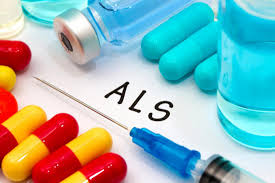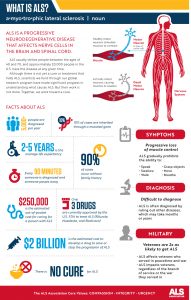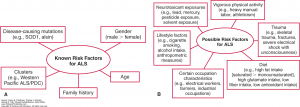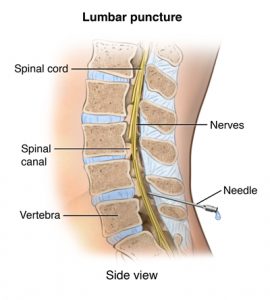 https://www.medicalnewstoday.com/articles/321900.php
https://www.medicalnewstoday.com/articles/321900.php
Amyotrophic lateral sclerosis (ALS), also known as Lou Gehrig’s disease, is a progressive neurodegenerative disease that affects neurons in the central nervous system (CNS). There are two types of ALS; familial and sporadic, the latter being more common. The eventual death of the motor neurons causes the loss of voluntary movement. There is currently no cure for ALS and eventually progresses until death, typically occurring two to five years after initial diagnosis. Currently, there is little known about the disease in science and in the general public, it’s causes, and what to do from here. It is important to know the possible warnings signs of ALS and symptology to raise awareness about the possibility developing the disease.

Image 1: An infographic containing a range of information about ALS
Image source: http://www.alsa.org/news/public-awareness/als-awareness-month/2016/what-is-als.html
Early Signs and Risk Factors
Unfortunately the most common risk factors and warnings signs can be similar to symptoms, as ALS tends to be undetectable until the disease has progressed. Some of the easier warning signs that you could be developing ALS include:
- Muscle weakness
- Trouble projecting the voice
- Difficulty swallowing
- Inability to stop laughing or crying
- Twitching of cramping of muscles
In addition to this, there are several risk factors that individuals should be aware of, especially when showing any of the symptoms listed above. Several risk factors that could predispose someone to ALS are:
- Family history
- Genetic factors and gene alterations
- Smoking (a controversial claim)
- Low intake of antioxidants and vitamin E
- High physical fitness and low body mass index
- Electrical occupations such as welding
- Head trauma
- Frontotemporal dementia
Despite what appears to be an overwhelming list, it is vital to know that there are certain environmental and genetic factors that may play a role in the development of ALS.

Image 2: Looking at the known risk factors that could lead to ALS and those that could be considered some but there remains further research into them to determine the validity of them.
Image source: https://fadavispt.mhmedical.com/Content.aspx?bookId=1895§ionId=136495898
Symptoms
Some of the symptoms that are commonly present themselves in ALS, also seen in the early signs, are:
- Difficulty with voluntary movement
- Tripping and falling
- Slurred speech
- Difficulty holding head and keeping posture
The symptoms usually begin in the extremities and begin to affect the core as the disease progresses.
How Physicians Diagnose ALS

Image 3: One of the ways that doctors diagnose ALS is by obtaining cerebrospinal fluid through a spinal tap, depicted in the image above. The need is inserted between vertebrae and draws the fluid out for testing.
Image source: https://www.cedars-sinai.org/health-library/diseases-and-conditions/a/amyotrophic-lateral-sclerosis-als.html
It is incredibly difficult to diagnose ALS, oftentimes the doctors must eliminate all other options before declaring a final diagnosis. ALS often mimics other neurological and neurodegenerative disease, which is the cause of the problem with diagnosis. There are test that exist that are able to rule out the other disease such as:
- EMG
- MRI
- Blood and urine test
- Spinal tap
- Muscle biopsy
Once diagnosed, an individual should keep track of the progression of the disease, as it worsens over time. One of the difficult aspects of ALS as well is the fact that there are no completely effective treatments.
Treatment and Therapies
There is no way to repair the damage that is done by ALS but there are treatments available that aim to slow the progression of the disease and lessen the severity of some of the other symptoms. There only two drugs that are currently approved by the FDA allowed to treat ALS itself. These are: Riluzole and Edaravone. Riluzole appears to slow the progression of ALS, perhaps by lowering the amount of glutamate in the brain. Edaravone, on the other hand, appears to lower the everyday cognitive decline that some patients experience during ALS. There are adverse side effects that are associated with both drugs.

Image 4: Doctors and researchers are working on new therapies and drugs to improve the quality of life as well as increasing life expectancy of those diagnosed with ALS.
Image source: https://www.israel21c.org/als-treatment-to-begin-phase-3-clinical-trials-in-us/
Some therapies exist such as breathing and speech therapies that aim to increase the quality of life. Social and psychological support groups also exist for those with ALS as well, as a resource for those to remember that they are not alone.
What to Remember
ALS is a complex disease that much more research needs to be conducted on to fully understand. The most important aspect of ALS is not necessarily the science but rather the people who experience the disease. The education of the public is so important so those with ALS to act as a support system and resource. Learn more about ALS and become and ally!
Sources:
http://www.alsa.org/about-als/what-is-als.html
https://blog.ochsner.org/articles/quick-guide-to-als-warning-signs